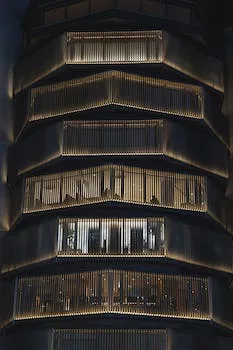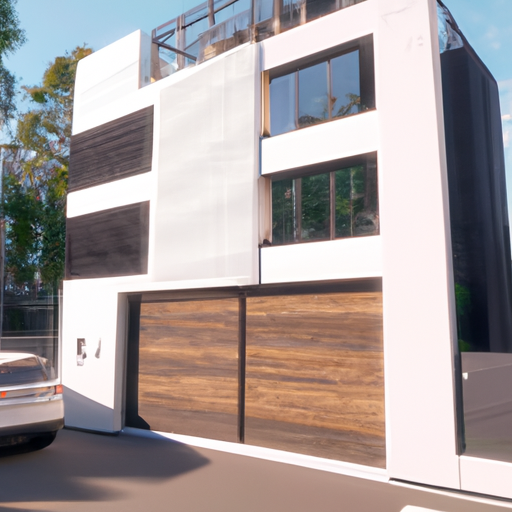Maximizing Space Efficiency: Innovative Design Solutions for Single Occupant Complexes
The role of design in creating a modern complex that’s perfect for a single person cannot be overstated. As urban populations continue to grow and living spaces become increasingly limited, architects and designers are faced with the challenge of creating functional, comfortable, and aesthetically pleasing living environments for single occupants. Maximizing space efficiency is a crucial aspect of this challenge, and innovative design solutions are constantly being developed to address the unique needs of single occupant complexes.
One of the primary concerns in designing a living space for a single person is ensuring that the limited square footage is used effectively. This often involves creating multi-functional spaces that can serve multiple purposes, such as combining a living room and a bedroom into a single area. To achieve this, designers may incorporate fold-out beds, retractable walls, or other space-saving features that allow the occupant to easily transform the space according to their needs.
Another important aspect of maximizing space efficiency is the strategic use of storage. In a small living environment, clutter can quickly become overwhelming, making it essential to provide ample storage solutions that are both functional and visually appealing. This can be achieved through the use of built-in storage units, such as floor-to-ceiling shelves or under-bed drawers, which can help to keep belongings organized and out of sight. Additionally, designers may opt for furniture pieces that double as storage, such as ottomans with hidden compartments or coffee tables with built-in shelves.
Lighting also plays a crucial role in creating a comfortable and inviting living space for a single person. In a small complex, natural light can be limited, making it important to incorporate a variety of artificial lighting options to create a warm and welcoming atmosphere. Designers may choose to use a combination of ambient, task, and accent lighting to achieve this effect, as well as selecting light fixtures that complement the overall design aesthetic of the space.
In addition to maximizing space efficiency, designers must also consider the social needs of single occupants. While living alone can offer a sense of independence and privacy, it can also lead to feelings of isolation and loneliness. To combat this, designers may choose to incorporate communal spaces within the complex, such as shared lounges, kitchens, or outdoor areas, where residents can gather and socialize with one another. These shared spaces can help to foster a sense of community and belonging among single occupants, while also providing opportunities for networking and forming new friendships.
Finally, the overall design aesthetic of a single occupant complex should be carefully considered to create a space that is both visually appealing and reflective of the occupant’s personal style. This can be achieved through the use of color, texture, and materials, as well as the selection of furniture and decorative elements. By creating a cohesive and well-designed living environment, designers can help to promote a sense of well-being and satisfaction among single occupants.
In conclusion, the role of design in creating a modern complex that’s perfect for a single person is multifaceted and requires a careful consideration of various factors, including space efficiency, storage, lighting, social needs, and aesthetics. By employing innovative design solutions and keeping the unique needs of single occupants in mind, architects and designers can create functional, comfortable, and visually appealing living spaces that cater to the modern urban dweller. As cities continue to grow and evolve, it is essential that design professionals rise to the challenge of creating living environments that not only maximize space efficiency but also promote a sense of well-being and satisfaction among their occupants.
Integrating Technology and Design: Creating Smart Living Spaces for the Modern Single Individual

The role of design in creating a modern complex that’s perfect for a single person cannot be overstated. As the number of single individuals continues to rise, there is an increasing demand for living spaces that cater to their unique needs and preferences. Integrating technology and design is essential in creating smart living spaces that are not only functional but also aesthetically pleasing and comfortable for the modern single individual.
One of the key aspects of designing a modern complex for a single person is to ensure that the living space is efficient and adaptable. This means that the space should be able to accommodate various activities and functions without compromising on comfort and style. For instance, a well-designed studio apartment should have a flexible layout that allows the occupant to easily switch between different modes of living, such as working, relaxing, and entertaining guests.
Incorporating technology into the design of a modern complex is crucial in achieving this level of adaptability and efficiency. Smart home systems, for example, can be integrated into the living space to allow the occupant to control various aspects of their environment, such as lighting, temperature, and security, with just a few taps on their smartphone or tablet. This not only makes the space more convenient and user-friendly but also helps to reduce energy consumption and promote sustainability.
Another important aspect of designing a modern complex for a single person is to create a sense of community and social interaction. While single individuals may enjoy their privacy and independence, they also need opportunities to connect with others and engage in social activities. This can be achieved by incorporating shared spaces and amenities within the complex, such as communal lounges, fitness centers, and outdoor terraces. These spaces should be designed to encourage interaction and foster a sense of belonging among the residents.
In addition to shared spaces, the design of individual living units should also promote social interaction. For example, large windows and balconies can help to create a sense of openness and connection with the surrounding environment, while open-plan layouts can make it easier for residents to entertain guests and interact with their neighbors. The use of technology can also play a role in facilitating social interaction, with features such as video intercom systems and smart locks allowing residents to easily communicate with and grant access to their guests.
The aesthetic appeal of a modern complex is another crucial factor in creating a living space that is perfect for a single person. The design should be contemporary and visually appealing, with a focus on clean lines, minimalist furnishings, and high-quality materials. This not only creates a sense of luxury and sophistication but also helps to maximize the sense of space and light within the living environment.
In conclusion, the role of design in creating a modern complex that is perfect for a single person involves a careful balance of functionality, technology, and aesthetics. By integrating smart home systems and other technological features, designers can create living spaces that are efficient, adaptable, and user-friendly. At the same time, the incorporation of shared spaces and amenities, as well as design elements that promote social interaction, can help to foster a sense of community and belonging among residents. Finally, a contemporary and visually appealing aesthetic can enhance the overall living experience and make the modern complex an attractive and desirable option for single individuals.
Balancing Functionality and Aesthetics: Key Design Principles for Crafting the Ideal Solo Living Environment
The role of design in creating a modern complex that’s perfect for a single person cannot be overstated. As more and more people choose to live alone, architects and interior designers are faced with the challenge of crafting living environments that cater to the unique needs and preferences of this growing demographic. Balancing functionality and aesthetics is crucial in this endeavor, as it ensures that the resulting spaces are not only visually appealing but also practical and conducive to a comfortable, efficient lifestyle. In this article, we will explore some key design principles that can help achieve this delicate balance and create the ideal solo living environment.
First and foremost, it is essential to prioritize space optimization. Given that single-person households typically have limited square footage, it is crucial to make the most of every available inch. This can be achieved through clever space planning and the use of multi-functional furniture. For instance, incorporating built-in storage solutions, fold-out desks, and convertible sofas can help maximize the utility of a small space without compromising on style. Additionally, employing a minimalist design approach can further enhance the sense of spaciousness, as it reduces visual clutter and promotes a sense of calm and order.
Another important aspect of designing for solo living is ensuring that the space is adaptable to the occupant’s changing needs and preferences. This can be achieved by incorporating modular elements and flexible layouts that can be easily reconfigured as required. For example, movable partitions or sliding doors can be used to create different zones within the space, allowing the occupant to switch between open-plan living and more private, enclosed areas as needed. Similarly, selecting furniture pieces that can be easily rearranged or repurposed can provide additional flexibility and enable the occupant to refresh the space without incurring significant costs or effort.
Lighting is another crucial element in crafting the perfect solo living environment. Given that natural light has been proven to have numerous psychological and physiological benefits, it is essential to maximize its presence in the space. This can be achieved by incorporating large windows, skylights, or glass doors, as well as by using reflective surfaces and light colors to enhance the sense of brightness and openness. Additionally, layering artificial lighting sources can help create a warm, inviting atmosphere and provide the necessary illumination for various tasks and activities. This can be achieved by combining ambient, task, and accent lighting, and by selecting fixtures that complement the overall design aesthetic.
Finally, personalization is key in creating a space that truly feels like home for the single occupant. This can be achieved by incorporating elements that reflect the individual’s personality, interests, and preferences, such as artwork, decorative objects, and unique furniture pieces. Additionally, using a cohesive color palette and design theme can help create a sense of harmony and unity, making the space feel more curated and intentional.
In conclusion, the role of design in creating a modern complex that’s perfect for a single person is multifaceted and requires a careful balance of functionality and aesthetics. By prioritizing space optimization, adaptability, lighting, and personalization, architects and interior designers can craft living environments that cater to the unique needs and preferences of solo dwellers, providing them with comfortable, efficient, and visually appealing spaces in which to live, work, and relax.
Q&A
Question 1: What are the key design elements to consider when creating a modern complex for a single person?
Answer 1: The key design elements to consider are efficient use of space, functionality, aesthetics, and integration of smart technology for convenience and security.
Question 2: How can designers ensure that a modern complex meets the needs of a single person while maintaining a sense of community?
Answer 2: Designers can achieve this by incorporating shared amenities such as communal lounges, co-working spaces, and outdoor areas, as well as organizing social events and activities to foster interaction among residents.
Question 3: What role does sustainability play in the design of a modern complex for a single person?
Answer 3: Sustainability plays a crucial role in the design by incorporating energy-efficient systems, eco-friendly materials, and green spaces to reduce the complex’s environmental impact and promote a healthy lifestyle for the resident.
Conclusion
In conclusion, the role of design in creating a modern complex for a single person is crucial, as it focuses on optimizing space, functionality, and aesthetics to cater to the unique needs and preferences of an individual. By incorporating innovative solutions, smart technology, and sustainable practices, designers can create a comfortable, efficient, and personalized living environment that enhances the overall quality of life for single occupants.


